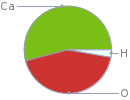Input interpretation

calcium hydroxide | elemental composition
Result

Find the elemental composition for calcium hydroxide in terms of the atom and mass percents: atom percent = N_i/N_total × 100% mass percent = (N_im_i)/m × 100% Plan: • Write the chemical formula and gather atomic masses from the periodic table. • Determine values for N_i, m_i, N_total and m using these items. • Finally, compute the percents and check the results. Write the chemical formula: Ca(OH)_2 Use the chemical formula to count the number of atoms, N_i, for each element and find the total number of atoms, N_total: | number of atoms Ca (calcium) | 1 H (hydrogen) | 2 O (oxygen) | 2 N_total = 1 + 2 + 2 = 5 Divide each N_i by N_total to calculate atom fractions. Then use the property that atom fractions must sum to one to check the work: | number of atoms | atom fraction Ca (calcium) | 1 | 1/5 H (hydrogen) | 2 | 2/5 O (oxygen) | 2 | 2/5 Check: 1/5 + 2/5 + 2/5 = 1 Compute atom percents using the atom fractions: | number of atoms | atom percent Ca (calcium) | 1 | 1/5 × 100% = 20.0% H (hydrogen) | 2 | 2/5 × 100% = 40.0% O (oxygen) | 2 | 2/5 × 100% = 40.0% Look up the atomic mass, m_i, in unified atomic mass units, u, for each element in the periodic table: | number of atoms | atom percent | atomic mass/u Ca (calcium) | 1 | 20.0% | 40.078 H (hydrogen) | 2 | 40.0% | 1.008 O (oxygen) | 2 | 40.0% | 15.999 Multiply N_i by m_i to compute the mass for each element. Then sum those values to compute the molecular mass, m: | number of atoms | atom percent | atomic mass/u | mass/u Ca (calcium) | 1 | 20.0% | 40.078 | 1 × 40.078 = 40.078 H (hydrogen) | 2 | 40.0% | 1.008 | 2 × 1.008 = 2.016 O (oxygen) | 2 | 40.0% | 15.999 | 2 × 15.999 = 31.998 m = 40.078 u + 2.016 u + 31.998 u = 74.092 u Divide the mass for each element by m to calculate mass fractions. Then use the property that mass fractions must sum to one to check the work: | number of atoms | atom percent | mass fraction Ca (calcium) | 1 | 20.0% | 40.078/74.092 H (hydrogen) | 2 | 40.0% | 2.016/74.092 O (oxygen) | 2 | 40.0% | 31.998/74.092 Check: 40.078/74.092 + 2.016/74.092 + 31.998/74.092 = 1 Compute mass percents using the mass fractions: Answer: | | | number of atoms | atom percent | mass percent Ca (calcium) | 1 | 20.0% | 40.078/74.092 × 100% = 54.09% H (hydrogen) | 2 | 40.0% | 2.016/74.092 × 100% = 2.721% O (oxygen) | 2 | 40.0% | 31.998/74.092 × 100% = 43.19%
Mass fraction pie chart

Mass fraction pie chart